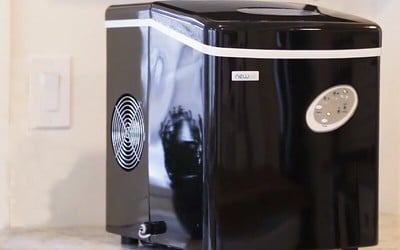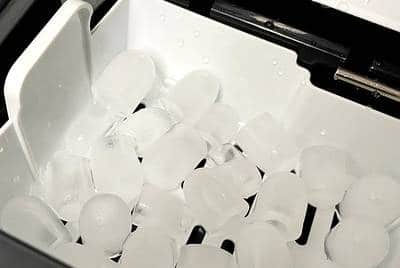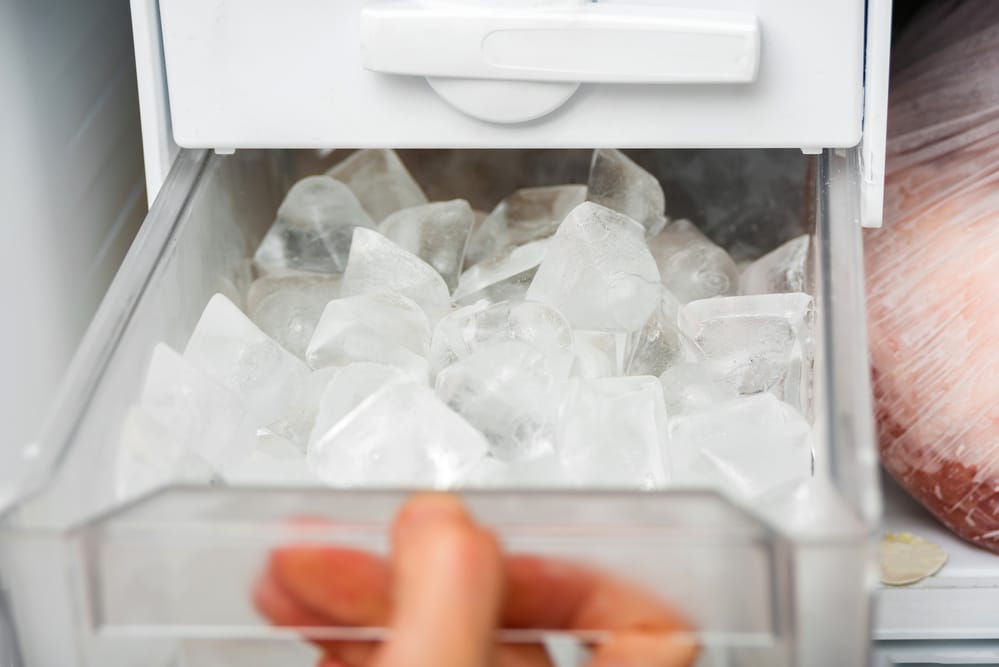An ice maker gives you an endless supply of ice without having to remember to fill up an ice cube tray and wait for the water to freeze. While it’s clear that ice makers are convenient, you might be interested in how they can keep the icebox topped up.
In this article, we will answer ‘how does an ice maker work?’ and show you how those perfect cubes are formed.
An Ice Makers’ Main Components and How They Make Ice Cubes
So, how does an ice maker work? To answer this question, we will look at the main components in the refrigeration process. The refrigeration system that makes an ice maker work is similar to the one in a freezer.
Refrigerant
Refrigerant has a very low freezing point and travels in the ice machine circuit to make the water cold enough to freeze. The refrigerant will change from liquid to vapour form and back as it passes through the closed circuit.
Compressor
The compressor pressurises the refrigerant from a low-pressure vapour into a high-pressure vapour and delivers it to the condenser. This first stage makes the refrigerant hotter as the pressure increases.
Condenser
The condenser is formed by a series of coiled metal tubes which the hot gas refrigerant passes through to lose its heat. As the refrigerant cools, it becomes condensed into a high-pressure liquid.
In many ice maker designs, electric fans blow air through the condenser to improve cooling efficiency. Other systems use a separate water supply to cool the condenser.
Thermostatic Expansion Valve
The high-pressure liquid is drained from the condenser via the thermostatic expansion valve.
The valve releases the pressure on the refrigerant liquid extremely quickly, which causes it to cool rapidly. The now low-pressure, low-temperature liquid is delivered to the evaporator.
Evaporator

An ice maker works by introducing water into an area cooled by the evaporator.
The low-temperature, low-pressure liquid enters the evaporator and heat from the surrounding air or water will travel across the evaporator plate. The refrigerant will warm up, and accordingly, the transfer of heat will chill the water to its freezing point.
As the refrigerant heats up in the evaporator, it will become a low-pressure vapour again and return to the compressor to repeat the cycle.
Ice Mould
Most ice makers use a freezer tray to hold the water. As the evaporator removes heat, the water will freeze into cubes.
Once the cubes are fully frozen, a heating coil will warm the ice trays to release the cubes for collection in the ice bin.
What Are the Different Types of Ice Machines?
Now that we have some idea of how the ice-making process freezes the water to make ice, let’s consider the available ice maker types.
Commercial Ice Makers
These ice makers are used in commercial locations to make ice. The most common application is in bars or restaurants, which use ice for serving drinks or keeping food chilled. However, you may also find them in healthcare facilities.
Commercial ice machines typically need to be able to make and store ice in large quantities.
Modular
A modular ice machine works where large quantities of ice are needed. They have a separate container that’s suitable sized to store and serve the amount of ice the business needs. These systems are commonly used in locations needing a high volume of ice production.
Under-Counter
An under-counter ice machine combines the maker with a storage bin in one unit. These are usually installed under the counter or bar and are used in facilities that need a lower amount of ice or don’t have the space available for a modular maker.
Countertop

A countertop ice machine is smaller and typically makes a lower amount of ice. They are popular anywhere where a small amount of ice is needed. These units are relatively portable and can be set up for temporary applications. They are often used in healthcare as the cubes produced are smaller and ideal for patients.
Combination
Combination makers include a chilled water dispenser with an ice maker. These appliances are ideal for offices, cafeterias and hospitals where drinking water and ice are needed.
Home Ice Machines
Home ice makers are smaller than commercial units, and they produce less ice. Some are stand-alone designs, while others are built into other kitchen appliances.
Countertop / Portable
A countertop or portable ice machine is a compact unit that can make relatively small amounts of ice quickly and easily. They don’t need to be connected to the mains water line, so they can be filled manually wherever they’re needed and are easy to clean as well. These designs usually use a thermoelectric heat exchanger rather than a compressor.
Under-Counter / Built-in
Built-in ice makers are a dedicated appliance if you need a reasonably large amount of ice in your home. These units need to be connected to the freshwater supply and drain, so they may need to be installed by a professional.
Refrigerator Ice Maker
Finally, we get to the most popular way of making ice at home, the type that is built into your refrigerator. These ice makers are compact and usually have the lowest ice storage capacity of all various designs. However, they are convenient and perfect if you need just some cubes to cool your drinks.
How Do Refrigerator Ice Makers Make Ice Cubes Without a Manual Ice Tray?
A refrigerator’s ice maker works inside a dedicated compartment where the evaporator can chill the ice mould. Ice is then stored in a frozen collection tray until needed.
- Fresh water enters the ice maker via a water filter or a refrigerator storage tank from the home plumbing line.
- An electronic water valve opens, and water flows into the ice mould until it’s filled, and a timer shuts the valve.
- The evaporator then chills the water in the tray until it is frozen into cubes.
- When the ice maker’s internal thermostat reads a temperature between about -12 and -15°C, the freezing process stops, and a heater warms the ice mould slightly to release the cubes.
- The ice maker motor moves the ejection arms to push the cubes out of the mould, and they fall into the collection tray, ready to use with the ice dispenser.
- The water valve will open to refill the mould and repeat the ice maker cycle.
- When the collection tray has enough ice, the shut-off arm raises and switches off the ice maker until sufficient ice is used to start the process again.
How Does a Portable Ice Machine Work?
I love you countertop ice maker pic.twitter.com/yFnjJABAE6
— a gallon of pcp (@vocaltest) March 9, 2022
Portable ice makers are self-contained units with a tank that you’ll need to pour water into before making ice. They freeze the water by direct contact from a heat exchanger and so can make ice faster than traditional designs.
- A water pump supplies water from the storage tank into the ice tray at the top of the ice maker.
- Prongs connected to the heat exchanger are lowered into the tray, and ice forms around them into cubes.
- The ice cubes’ size depends on the amount of time the heat exchanger works for. Any remaining water is drained back into the water tank when the time is up.
- The prongs then heat up slightly to release the cubes, and the clear ice produced is collected in the icebox as the ice maker cycle starts again to make more ice.
- A sensor monitors when the storage box is full and switches off the system.
The storage box on a portable ice maker is insulated but isn’t refrigerated. This means that the cubes will eventually melt. However, the water will drain back into the tank, topping it up for reuse in ice production.
Enjoy Your Favourite Drinks With Ice
As we’ve answered our initial question ‘how does an ice maker work?’, we’ve seen that most ice makers use a refrigeration cycle similar to that found in a freezer to chill a compartment containing an ice tray that is automatically filled and emptied continually.
Having an ice maker in your home means you never need to remember to fill up the tray again when you use the last cube. So, you can enjoy your favourite drinks with ice whenever you want them!
Additional Resources
- How to Make Courgette Noodles Without a Spiralizer
- How to Clean a Burnt Soup Maker
- How to Stop Bread From Going Mouldy in a Bread Bin
- How to Use a Waffle Maker
- How to Install an Under Sink Water Filter System
Tom is a former chef turned full-time food blogger. He has always been passionate about food, and loves nothing more than experimenting in the kitchen and sharing his recipes with others. Tom’s blog is one of the most popular food blogs on the internet, and he has won numerous awards for his cooking. When he’s not blogging or cooking, Tom enjoys spending time with his wife and two young children.

